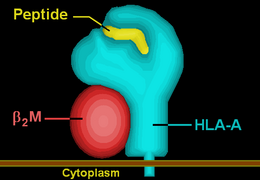HLA-A43 (A43) is a human leukocyte antigen serotype within HLA-A serotype group. The serotype is determined by the antibody recognition of α43 subset of HLA-A α-chains. For A43, the alpha "A" chain are encoded by the HLA-A*43 allele group and the β-chain are encoded by B2M locus.[1] This group currently is dominated by A*4301. A43 and A*43 are almost synonymous in meaning. A43 is a split antigen of the broad antigen serotype A10. A43 is a sister serotype of A25, A26, A34, and A66.
| HLA-A43 | ||||||||||||||||
|---|---|---|---|---|---|---|---|---|---|---|---|---|---|---|---|---|
| (MHC Class I, A cell surface antigen) | ||||||||||||||||
 HLA-A43 | ||||||||||||||||
| About | ||||||||||||||||
| Protein | transmembrane receptor/ligand | |||||||||||||||
| Structure | αβ heterodimer | |||||||||||||||
| Subunits | HLA-A*4301, β2-microglobulin | |||||||||||||||
| Older names | A10 | |||||||||||||||
| Subtypes | ||||||||||||||||
| ||||||||||||||||
| Alleles link-out to IMGT/HLA database at EBI | ||||||||||||||||
A43 is more common in Africa and SouthWest Asia. A43 is believed to have been formed by a single gene conversion between another HLA-A and the A*2601 allele.[2].
Serotype
edit| A*43 | A43 | A26 | Sample |
| allele | % | % | size (N) |
| *4301 | 0 | 35 | 9 |
A43 serotyping is poor.
Distribution
edit| freq | ||
| ref. | Population | (%) |
| [4] | South Africa Tswana | 4.9 |
| [4] | South African Natal Zulu | 3.0 |
| [4] | China Yunnan Han | 1.2 |
| [4] | Zambia Lusaka | 1.2 |
| [4] | Pakistan Karachi Parsi | 0.6 |
| [4] | India North Delhi | 0.5 |
| [4] | Zimbabwe Harare Shona | 0.4 |
| [4] | Italy | 0.01 |
| [4] | China Shanghai | 0.002 |
References
edit- ^ Arce-Gomez B, Jones EA, Barnstable CJ, Solomon E, Bodmer WF (February 1978). "The genetic control of HLA-A and B antigens in somatic cell hybrids: requirement for beta2 microglobulin". Tissue Antigens. 11 (2): 96–112. doi:10.1111/j.1399-0039.1978.tb01233.x. PMID 77067.
- ^ Madrigal JA, Hildebrand WH, Belich MP, et al. (1993). "Structural diversity in the HLA-A10 family of alleles: correlations with serology". Tissue Antigens. 41 (2): 72–80. doi:10.1111/j.1399-0039.1993.tb01982.x. PMID 8475492.
- ^ Allele Query Form IMGT/HLA - European Bioinformatics Institute
- ^ a b c d e f g h i Middleton D, Menchaca L, Rood H, Komerofsky R (2003). "New allele frequency database". Tissue Antigens. 61 (5): 403–7. doi:10.1034/j.1399-0039.2003.00062.x. PMID 12753660.